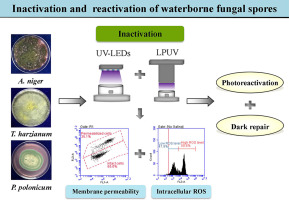当前位置:
X-MOL 学术
›
Water Res.
›
论文详情
Our official English website, www.x-mol.net, welcomes your
feedback! (Note: you will need to create a separate account there.)
Comparison of UV-LEDs and LPUV on inactivation and subsequent reactivation of waterborne fungal spores.
Water Research ( IF 11.4 ) Pub Date : 2020-01-29 , DOI: 10.1016/j.watres.2020.115553 Qiqi Wan 1 , Gang Wen 1 , Ruihua Cao 1 , Xiangqian Xu 1 , Hui Zhao 1 , Kai Li 1 , Jingyi Wang 1 , Tinglin Huang 1
Water Research ( IF 11.4 ) Pub Date : 2020-01-29 , DOI: 10.1016/j.watres.2020.115553 Qiqi Wan 1 , Gang Wen 1 , Ruihua Cao 1 , Xiangqian Xu 1 , Hui Zhao 1 , Kai Li 1 , Jingyi Wang 1 , Tinglin Huang 1
Affiliation

|
Recently, the contamination of fungi in water supply systems has been an area of increasing concern, such as Aspergillus spp. and Penicillium spp. It can cause some waterborne issues such as odor, taste and formation of mycotoxins. Ultraviolet light emitting diodes (UV-LEDs) are considered as a potential alternative to conventional mercury lamps for water disinfection. This study has compared the performance of LPUV (low pressure ultraviolet) and UV-LEDs with emissions at 265, 280 nm and combination emissions at 265/280 nm to test inactivation efficiency, reactivation, viability and electrical energy consumption in the treatment of three water-borne fungal species (Aspergillus niger, Penicillium polonicum, Trichoderma harzianum) at a batch water disinfection system. The results showed that the performances of UV-LEDs were superior for the inactivation of fungal spores compared to the 254 nm (LP), while no statistically differences were observed among the UV-LEDs (p > 0.05). The average photoreactivation rate (k1) of fungal spores irradiated by UV-LEDs and 254 nm (LP) follows the order: T. harzianum > A. niger > P. polonicum. Compared with LPUV, UV-LEDs irradiation at 280 nm and 265/280 nm more efficiently inhibits photoreactivation, which was attributed to that irradiation of 280 nm and 265/280 nm would cause greater membrane damage and increase intracellular reactive oxygen species level of fungal spores according to the flow cytometric results. The electrical energy consumption of UV-LEDs was higher than that of LPUV, which was due to its lower wall plug efficiency. The results of this study can provide additional and beneficial information for the reasonable exploitation of UV-LEDs in water disinfection.
中文翻译:

UV-LEDs和LPUV对水性真菌孢子灭活和随后再活化的比较。
近来,供水系统中真菌的污染已成为人们日益关注的领域,例如曲霉属。和青霉菌属。它可能会引起一些水性问题,例如气味,味道和霉菌毒素的形成。紫外线发光二极管(UV-LED)被认为是用于水消毒的传统汞灯的潜在替代品。这项研究比较了LPUV(低压紫外线)和UV-LED在265、280 nm处的发射以及265/280 nm处的组合发射的性能,以测试三种水处理时的灭活效率,再活化,活性和电能消耗分批水消毒系统中携带的真菌菌种(黑曲霉,青霉菌,哈茨木霉)。结果显示,与254 nm(LP)相比,UV-LED的性能优于254 nm(LP),对真菌孢子的灭活效果更好,而在UV-LED之间无统计学差异(p> 0.05)。UV-LED和254 nm(LP)照射的真菌孢子的平均光再活化速率(k1)遵循以下顺序:哈茨木霉(T. harzianum)>黑曲霉(A. niger)> pol。polonicum。与LPUV相比,UV-LEDs在280 nm和265/280 nm处的照射更有效地抑制了光活化,这归因于280 nm和265/280 nm的照射会引起更大的膜损伤并增加真菌孢子的细胞内活性氧种类水平。根据流式细胞仪结果。UV-LED的电能消耗比LPUV高,这是由于其壁挂效率较低。
更新日期:2020-01-29
中文翻译:

UV-LEDs和LPUV对水性真菌孢子灭活和随后再活化的比较。
近来,供水系统中真菌的污染已成为人们日益关注的领域,例如曲霉属。和青霉菌属。它可能会引起一些水性问题,例如气味,味道和霉菌毒素的形成。紫外线发光二极管(UV-LED)被认为是用于水消毒的传统汞灯的潜在替代品。这项研究比较了LPUV(低压紫外线)和UV-LED在265、280 nm处的发射以及265/280 nm处的组合发射的性能,以测试三种水处理时的灭活效率,再活化,活性和电能消耗分批水消毒系统中携带的真菌菌种(黑曲霉,青霉菌,哈茨木霉)。结果显示,与254 nm(LP)相比,UV-LED的性能优于254 nm(LP),对真菌孢子的灭活效果更好,而在UV-LED之间无统计学差异(p> 0.05)。UV-LED和254 nm(LP)照射的真菌孢子的平均光再活化速率(k1)遵循以下顺序:哈茨木霉(T. harzianum)>黑曲霉(A. niger)> pol。polonicum。与LPUV相比,UV-LEDs在280 nm和265/280 nm处的照射更有效地抑制了光活化,这归因于280 nm和265/280 nm的照射会引起更大的膜损伤并增加真菌孢子的细胞内活性氧种类水平。根据流式细胞仪结果。UV-LED的电能消耗比LPUV高,这是由于其壁挂效率较低。











































 京公网安备 11010802027423号
京公网安备 11010802027423号